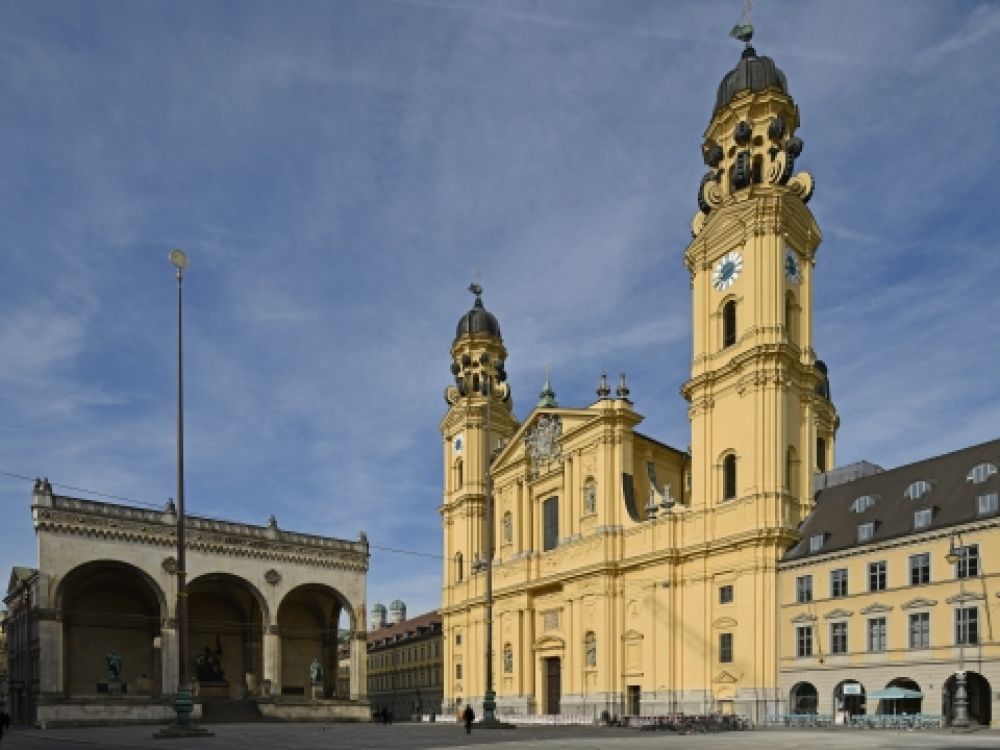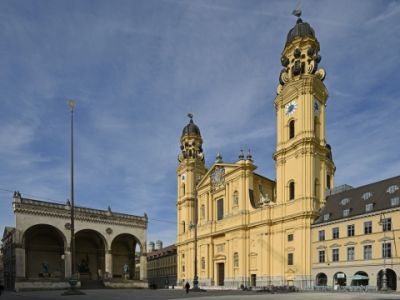

The Theatine Church, or Theatinerkirche, is a historical landmark and a prime example of Italian high-Baroque architecture in Germany. Embark on a guided tour to learn about the church's origins, dating back to 1663, when it was built by Elector Ferdinand Maria and his wife, Henriette Adelaide of Savoy, as a gesture of thanks for the birth of their long-awaited heir. Marvel at the elaborate stucco work by the Italian artist Agostino Barelli, and the numerous statues and paintings that adorn the interior. Hear stories about the church's role in Bavarian history and learn about the significant restoration efforts following the destruction during World War II. The tour can also include insights into the daily life of the Theatines, the religious order the church is named after.
Taking part in a church service at Theatinerkirche offers visitors a unique opportunity to experience the spiritual ambiance of this regal place of worship. The church services are conducted regularly and visitors are welcomed to join in the community to celebrate Mass. The church's acoustics lend themselves beautifully to the sound of the organ and choir, creating an ethereal musical experience. Participate in the liturgical traditions and you may also have the chance to experience the church's rich musical heritage during special services where sacred music is performed.
The Theatine Church not only serves as a place of worship but also as a concert venue, hosting various classical music performances throughout the year. With its impressive acoustics and stunning backdrop, the church is a popular location for enjoying works by famous composers. Attend a concert to listen to skilled musicians playing pieces from different eras – from Baroque to Classical to contemporary works. The experience of live music in such a historic setting is truly enchanting and stays with you long after the last note has been played.
Photography enthusiasts will find the Theatine Church a perfect subject for a self-guided photo tour. Capture the stunning yellow façade and the intricate rococo designs of the church's interior. Take your time to compose the perfect shot of the grand altar, the frescoed ceilings, and the natural light filtering through the windows, creating captivating light-and-shadow effects. While tripods may not be allowed without permission, there is ample opportunity to take hand-held photos of this photogenic church. Remember to be respectful of services and visitors when photographing inside the church.
Art lovers can specifically focus on the abundance of Baroque art present within the Theatine Church. Discover treasured artworks by numerous famous artists of the era. Each painting and sculpture has a story to tell, from representations of biblical scenes to depictions of saints. Guests can admire the dramatic flair of Baroque art and examine the details of each piece at their own pace. Booklets or apps detailing the significance of each artwork may be available to enhance the experience.
The crypt of Theatinerkirche is a must-see for history buffs. Buried here are members of the Wittelsbach dynasty, which ruled Bavaria for centuries. The crypt offers a somber contrast to the lively Baroque architecture upstairs, and exploring it allows visitors to delve into the personal histories of the individuals who shaped Bavaria's history. Note the different architectural styles of the sarcophagi and read inscriptions that tell tales of power, influence, and the human side of Bavaria's royalty. Access to the crypt may be limited, so ensure to check the visiting hours beforehand.
The Theatine Church is an oasis of tranquility amidst the bustling city of Munich. Visitors are welcome to take a peaceful moment for meditation or prayer in the serenity of this Baroque masterpiece. Sit in the pews and reflect while surrounded by the elaborate ornamental designs and the calming presence of the sacred space. The church aims to be an inclusive environment where individuals from all walks of life can find solace and spiritual replenishment.
Students of architecture and design can benefit greatly from a study visit to Theatinerkirche. The church is an exemplar of high-Baroque architecture, with influences from Italian and French designs. Examine the stucco work in detail, identify the characteristics that define Baroque art, and trace the evolution of the church's construction and restoration over the centuries. The visit is both an educational experience and a chance to appreciate the fusion of artistic and architectural brilliance.
Throughout the liturgical year, The Theatine Church holds special services and religious celebrations such as Easter, Christmas, and feast days dedicated to saints. Attending one of these events allows visitors to immerse themselves in the religious and cultural traditions of Munich. The services usually include special music, prayers, and sometimes processions. They offer a deeper insight into the faith that inspired the creation of this remarkable building and continue to drive its community today.
Families with children can take advantage of various educational programs and workshops conducted at Theatinerkirche. These activities are designed to teach children about the church's history, art, architecture, and role in the community in an interactive and engaging way. Through hands-on experiences, storytelling, and creative activities, children can learn about this important cultural landmark in a manner that is accessible and fun for them.
